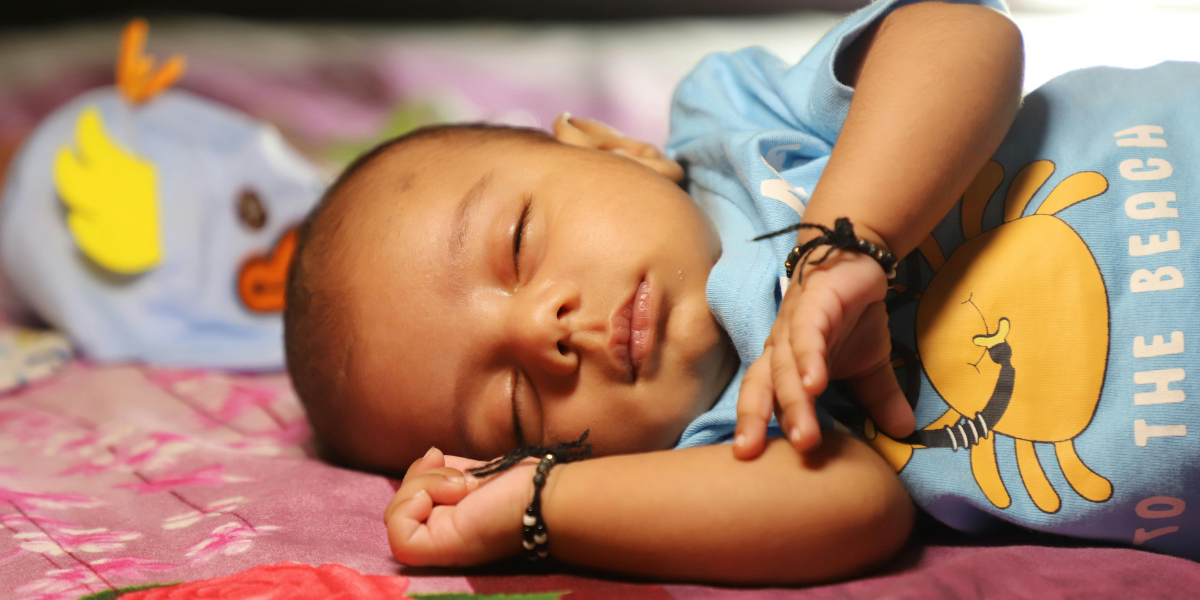Sleep is one of the biggest challenges for new parents. Teaching a baby how to sleep independently—often called sleep training—can feel overwhelming, but with the right timing, method, and consistency, most families see positive results. At Chapter 1 Daycare, we work with families in Calgary every day to support healthy routines, so we understand both the science and the practical realities of helping babies learn strong sleep skills.
This guide explains what sleep training means, when to start sleep training a baby, the most common methods, and how daycare and home routines can align to give your child the best rest possible.
What Sleep Training Really Means
Sleep training is the process of helping a baby learn to fall asleep and return to sleep without constant parental assistance. The goal is not to leave a child alone, but to gradually teach self-soothing skills.
It’s important to distinguish between sleep training and safe sleep habits. Safe sleep means placing your baby on their back, using a firm flat mattress, and avoiding loose bedding or soft toys. Sleep training builds on those foundations by teaching your baby how to transition between sleep cycles without rocking, feeding, or holding every time they stir.
When to Start Sleep Training Baby

Parents often ask us, “When should I begin?” Most experts agree that the best window is around 4 to 6 months of age. By this time, babies usually:
-
Show more predictable nap and wake cycles.
-
No longer need frequent nighttime feeds for growth (though some may still need one feed).
-
Have developed enough neurologically to begin self-soothing, such as briefly sucking a thumb or turning their head to settle.
Starting earlier than 4 months is usually discouraged, because babies still need very frequent feeding and their sleep cycles are immature. Waiting until after 6 months is fine, but habits can become more ingrained and harder to change.
Every child is different, and premature babies or those with medical needs may need to wait longer. We always recommend discussing timing with your pediatrician before beginning formal sleep training.
Signs Your Baby Is Ready
Look for these readiness cues before you begin:
-
Baby can stay awake for at least 2 hours between naps without becoming overtired.
-
Weight gain is consistent and your pediatrician is satisfied with growth.
-
Bedtime and wake time are roughly predictable each day.
-
Baby shows self-soothing signs such as rubbing eyes, sucking on fingers, or calming after brief fussing.
If several of these apply, your baby is probably ready to begin structured training.
Sleep Training Methods Explained
There isn’t one “best” method—different approaches work for different families. Here are the main techniques parents use:
Graduated Extinction (Ferber Method)
Parents place the baby in the crib awake, then leave the room and return at set intervals (for example, after 3 minutes, then 5, then 10). Comfort is brief and consistent—patting or reassuring words—before leaving again. This method is effective within 3–7 nights for many families, though it requires persistence.
Extinction (Cry It Out)
Parents put the baby to bed and do not return until morning. Some families see very fast results, but many find the first nights emotionally challenging. Because of the intensity, this approach is less commonly chosen today.
Chair Method (Fading)
Parents sit in a chair beside the crib and gradually move the chair farther away over several nights until the baby falls asleep independently. This is gentler but usually takes longer—often two weeks or more.
Pick-Up/Put-Down
Parents pick up the baby when crying, soothe briefly, and place them back in the crib while drowsy but awake. This repeats until the baby settles. It’s more hands-on but helps families who prefer gradual comfort.
Gentle Sleep Training Approaches
Some families adapt routines by slowly reducing rocking, feeding, or contact over several weeks. This can be effective but requires consistency and patience.
The key is to pick one method, commit to it for at least 1–2 weeks, and avoid switching mid-way, which confuses babies and delays progress.
A Two-Week Starter Plan
We suggest parents think of sleep training as a process, not an overnight fix. A structured 2-week approach works well for many families:
Week 0 (Preparation)
-
Create a consistent bedtime routine: bath, feeding, quiet cuddle, song, and crib.
-
Darken the room with blackout curtains.
-
Introduce white noise.
-
Ensure naps are at predictable times.
Week 1 (Implementation)
-
Place your baby in the crib drowsy but awake.
-
Follow your chosen method—whether graduated extinction, fading, or gentle pick-up/put-down.
-
Keep responses consistent each night.
Week 2 (Consistency & Adjustment)
-
Gradually increase intervals or reduce intervention as your method requires.
-
Track progress in a log to see trends.
-
Avoid new sleep crutches, such as extended rocking, during regressions.
By the end of two weeks, most babies show clear improvement—falling asleep faster and waking less overnight.
Night Feeding, Growth, and Special Considerations
Not every baby is ready to drop all night feeds at 4 months. Many still need one nighttime feed until 6–7 months. The goal of sleep training is not to deny nutrition, but to separate genuine hunger from habitual waking.
To do this safely:
-
Discuss night-feed weaning with your pediatrician.
-
For breastfed babies, ensure feeds are efficient and full before bedtime.
-
For formula-fed babies, aim for adequate ounces during the day.
-
If your pediatrician confirms growth is on track, gradually reduce night feeds while maintaining training.
Pause sleep training during illness, growth spurts, travel, or major disruptions, and resume when your baby is healthy and routines are stable.
Common Problems and Solutions
Extinction Burst
It’s common for crying to worsen around night 3 or 4 before improving. Stay consistent—this is a sign your baby is testing the new routine.
Sleep Regressions
At 4 months, 8–10 months, and 18 months, babies often regress due to developmental leaps. Keep routines steady, shorten interventions if needed, and continue training.
Separation Anxiety
Around 9 months, babies may resist being alone. Gentle fading or chair methods help during this phase while maintaining consistency.
Early Morning Waking
Babies often wake at 5 a.m. If so, check for early light, adjust bedtime slightly, or resettle without feeding.
How Chapter 1 Daycare Supports Sleep Training
We understand that consistency matters. That’s why at Chapter 1 Daycare in Calgary, we:
-
Mirror home sleep cues such as white noise or comfort objects.
-
Maintain age-appropriate nap schedules aligned with your child’s home routine.
-
Create a calm environment with dim lights and soothing pre-nap rituals.
-
Share sleep logs with parents so progress is monitored both at home and at daycare.
By working together, families see faster results and babies adjust more smoothly.
Safety and Attachment
One of the most common fears is that sleep training will harm attachment. Research shows that when done appropriately, short-term crying does not cause emotional harm. Secure attachment is built during the day through responsive care, play, and affection.
Remember: sleep training is not about withholding love. It’s about teaching your child an important developmental skill—falling asleep independently.
When to Seek Professional Guidance
If misbehavior or sleep issues are extreme, persistent, or disrupting daily life at home or daycare, consult a pediatrician or sleep consultant. Conditions like reflux, developmental delays, or sensory sensitivities can affect sleep.
At Chapter 1 Daycare, we document sleep patterns and share them with parents to support pediatric consultations when needed. Early support ensures children receive the right strategies and interventions.
Checklist: Are You Ready to Begin?
Before starting, ask yourself:
-
Is my baby at least 4 months old and gaining weight steadily?
-
Are bedtime and naps somewhat predictable?
-
Am I and my co-parent ready to stay consistent for at least 1–2 weeks?
-
Do we have a quiet, safe sleep environment set up?
If the answer is yes, you’re ready to start.
Additional Reading Material
- Tips to Help Your Kids Sleep Better
- How to Help Your Preschooler Sleep Better
- Why Growing Kids Need Adequate Sleep
Conclusion
Most babies are ready to begin sleep training around 4 to 6 months. Choosing a method that matches your family’s comfort, committing to it consistently, and aligning daycare and home routines make the process smoother.
At Chapter 1 Daycare, we support parents through every step, reinforcing sleep routines during the day and sharing insights that help at night. Sleep training is a journey, but with patience and consistency, your baby can learn to sleep independently, giving the whole family more rest.

